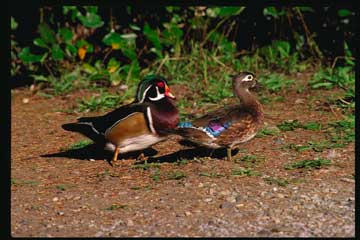
Standard English Name(s): wood
duck
Local English Name(s):
Scientific Name(s): Aix sponsa (Linnaeus)
Upriver Halkomelem Name(s):
Downriver Halkomelem Name(s):
Island Halkomelem Name(s):
Description, Habitat, Ecology, & Distribution:
Considered by many to be our most beautiful
local duck, the wood duck is uniquely multicoloured with a sleek crest
of feathers on the nape of the neck. As is typical for birds, the male
is the more colourful of the sexes, having iridescent greens, purples,
and blues as well as a white chin patch and a bill that is mainly red.
Females are greyish with a broad white eye ring. The genus name, Aix,
comes from Greek where it originally referred to some unidentified type
of waterfowl. The specific name, sponsa, is Latin for "betrothed"
(i.e., as a bride). This name is applied either for the bird's attractive
appearance (as if dressed for a wedding) or because of the similarity
of this duck to the closely related Mandarin duck (A. galericulata),
which formerly was given as a traditional gift in China to symbolize
marital fidelity.
Wood ducks are perching ducks that use
their sharp claws to perch on snags, stumps, or branches. These woodland
ducks inhabit wooded rivers, ponds, and swamps, nesting in tree cavities.
For this reason this species is known elsewhere in Canada as bush duck
or tree duck. Wood ducks are relatively common throughout the Fraser
Lowlands and on southern Vancouver Island where they breed from approximately
April to early September. They feed upon seeds, acorns, fruits, insects,
and other invertebrates.
Upriver Halkomelem Cultural Role(s):
Downriver Halkomelem Cultural Role(s):
Island Halkomelem Cultural Role(s):